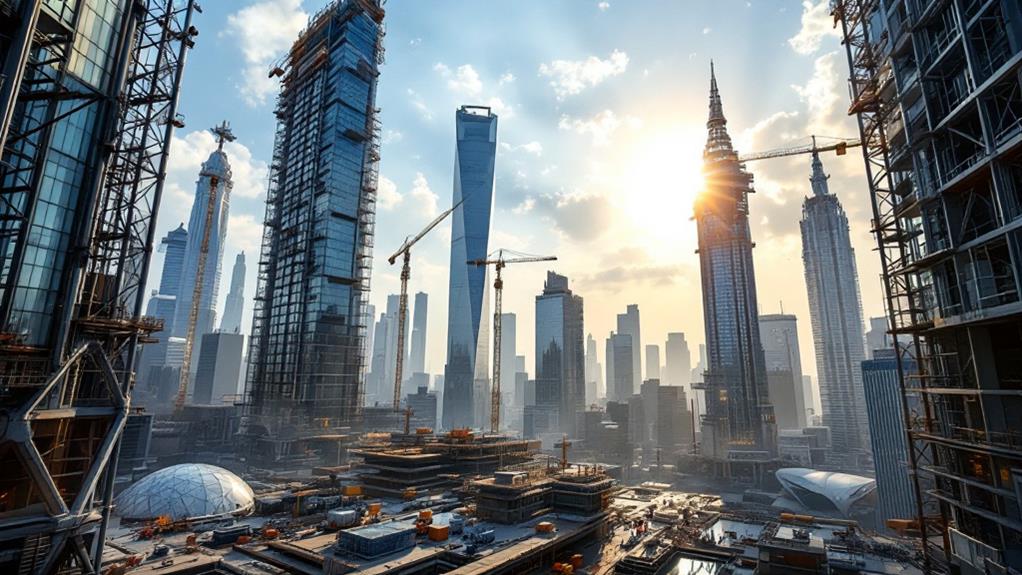The Engineering Feats Behind the Largest Skyscrapers

You've probably marveled at the towering heights of today's skyscrapers, wonders of engineering that defy gravity and weather. Engineers tackle challenges like wind resistance using wind tunnel testing and dampers to minimize sway. They stretch height boundaries with groundbreaking designs like bundled and perimeter tubes, maximizing space while maintaining stability. Modern materials like high-strength concrete and steel composites provide unmatched strength and flexibility. These feats blend ambition with practical considerations, from environmental impacts to urban planning. Each advancement builds on past successes, setting the stage for even taller and more resilient structures as you continue to investigate this fascinating field.
Evolution of Skyscraper Heights
Witnessing the evolution of skyscraper heights is like watching a race of architectural innovation unfold. You're engaged in the story of how these engineering feats came to be, each structure vying to be the world's tallest building. The Chrysler Building once held the crown, reaching a building height of 319 meters, only to be quickly eclipsed by the Empire State Building at 381 meters. This leap in skyscraper construction was achieved through 15 design iterations, showcasing the relentless pursuit of height and grandeur.
As you trace this expedition, the World Trade Center emerges, surpassing the Empire State Building with its perimeter tube design. At 417 meters, this skyscraper construction marvel efficiently increased office space by minimizing internal columns, setting a new standard for tallest buildings. Then, the Sears Tower enters the scene with a bundled tube design, elevating the building height to 442 meters. This design improved wind resistance and structural stability, further refining skyscraper engineering.
The race continues globally as the Petronas Towers and Jetta Tower push boundaries, with the latter projected to exceed one kilometer. Each advancement underscores the ongoing ambition driving the evolution of skyscraper heights.
Overcoming Structural Challenges
As skyscrapers reach unprecedented heights, the challenges of maintaining structural integrity become more complex and fascinating. Tall buildings, like the 432 Park Avenue with its 15:1 height-to-width ratio, demand cutting-edge engineering techniques to guarantee structural stability. When you're dealing with such slender structures, thicker walls and advanced technologies are essential. Ratios beyond 8:1 or 9:1 substantially increase construction costs, but the innovations in modern concrete—five times stronger than traditional materials—allow you to build taller without needing bulkier designs.
Wind management is critical in these towering giants. Engineers rely on wind tunnel testing to shape buildings that can disrupt harmful vortices, which helps reduce oscillation during strong gusts. To further improve stability, tuned mass dampers are often installed. These dampers can limit movement at the top of a building to just 2.5 feet, even during extreme wind events, guaranteeing the skyscraper remains steady and safe.
Wind Resistance Strategies

Imagine standing at the base of a towering skyscraper, where managing the force of the wind is a significant concern. The wind is the primary external force that tall buildings face, demanding groundbreaking design strategies to minimize sway and guarantee stability. To tackle this, architects employ several techniques. Wind tunnel testing is a vital step, allowing designers to analyze airflow and create shapes that disrupt wind vortices, thereby reducing oscillation.
Key Design Strategies for Wind Resistance:
- Corner Shapes: Rounded, chamfered, or notched corners help break up wind patterns, preventing smooth surfaces that could amplify forces.
- Dampers: Though details on dampers will follow, they're fundamental for acting as shock absorbers, limiting building movement during high winds.
- Structural Concepts: Innovations like the bundled tube concept, as seen in the Sears Tower, distribute forces across interconnected tubular structures for improved wind resistance.
These strategies guarantee that even the tallest buildings, like the iconic Sears Tower, remain stable and safe. By incorporating these advanced design features, engineers have successfully kept top floor sway to a minimum, often restricting it to just 2.5 feet in extreme conditions. Such feats highlight the vital importance of wind resistance in skyscraper design.
Role of Dampers in Stability
In the quest for skyscraper stability, dampers play a fundamental role, acting as essential shock absorbers that counteract wind-induced vibrations and keep occupants comfortable. As skyscrapers reach new heights, their slender forms face greater challenges from the wind. Dampers, like tuned mass dampers, step in to mitigate these effects. They work by absorbing and dissipating the energy from wind-induced vibrations, ensuring the building remains stable and occupants feel at ease.
You'll find two main types of dampers: tuned mass dampers and slosh dampers. Tuned mass dampers often include actuators for improved performance, while slosh dampers use fluid movement to counteract sway. The Shanghai Tower takes it a step further with a unique system that incorporates magnets, providing exceptional stability during extreme weather conditions. These advanced systems can limit the movement of a building's top floor to just 2.5 feet during high winds, which considerably reduces discomfort and structural stress.
As the height-to-width ratio of skyscrapers increases, implementing effective dampers becomes even more essential. Without them, the greater wind-induced oscillations could lead to excessive swaying, affecting both the structure and those inside.
Modern Building Materials

While dampers play a crucial role in skyscraper stability, the quest for ever-taller buildings demands more than just mechanical solutions; it requires state-of-the-art materials. Modern building materials have transformed the landscape of skyscraper construction, allowing for unprecedented heights and designs. Modern concrete, for instance, is up to five times stronger than traditional formulations. This remarkable strength lets you build taller structures without greatly increasing their structural size. Furthermore, many of these cutting-edge concrete compositions incorporate industrial by-products, improving both their strength and sustainability.
Advancements in material science have also led to composite structures combining steel and concrete. These hybrids elevate load-bearing capacities, offering engineers and architects the flexibility to push the boundaries of height and design. This progress paves the way for groundbreaking designs that prioritize aesthetics and structural integrity.
Here's how modern building materials impact skyscraper construction:
- Strength and Sustainability: Incorporate stronger, sustainable materials to build higher and greener.
- Composite Structures: Use steel and concrete together to increase load-bearing capacities.
- Groundbreaking Designs: Enable creative architectural designs that don't compromise on stability.
Future Skyscraper Innovations
As skyscrapers continue to reach unprecedented heights, the future of these towering structures promises exciting advancements that will redefine urban skylines. The Jetta Tower, set to exceed 1 kilometer, exemplifies this by integrating groundbreaking elevator passage walls directly into its structural system. This approach improves both efficiency and functionality, marking a significant leap in skyscraper design. Future skyscrapers will likely shift from traditional curtain walls to advanced core structures that provide greater stability and support at extreme heights.
Maximizing natural light while maintaining structural integrity is another key focus. You'll see unique architectural shapes and materials being employed to guarantee these massive buildings are not only stable but also bright and inviting. Construction technology is evolving with stronger composite materials and smart building systems, enabling even taller and more resilient structures. These advancements are crucial for the future of construction.
As environmental concerns grow, future skyscrapers will increasingly incorporate sustainable features. Green technologies will become standard to reduce carbon footprints, making these giants not only engineering marvels but also environmentally responsible. The fusion of cutting-edge technology and sustainability will define the next generation of skyscrapers, transforming how we view urban landscapes.



